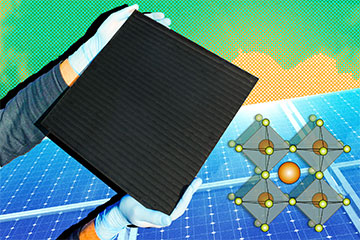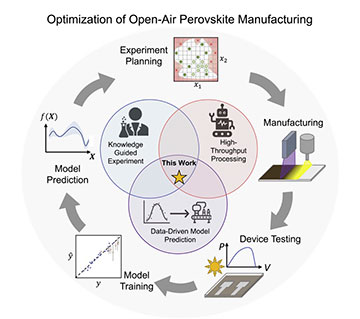
The optimized production of perovskite solar cells could be sped up thanks to a new machine-learning system. [Image: Photo of solar cell by N. Rolston, Stanford University, and edited by MIT News. Perovskite illustration by C. Daniloff, MIT.]
Perovskite-based solar cells are efficient absorbers and are lighter and thinner than today’s silicon-based solar cells. However, scaling up perovskite production to commercial levels remains a challenge. Now, researchers at the US-based institutions Stanford University and the Massachusetts Institute of Technology (MIT) have developed a machine-learning approach for optimizing the high-throughput production of perovskite materials that could help position perovskite solar cells to replace silicon-based cells in the near future (Joule, doi: 10.1016/j.joule.2022.03.003).
The researchers rapidly improved a perovskite manufacturing process by incorporating data and qualitative observations from previous production experiments into a sequential process-optimization framework. After only five process refinements, the researchers manufactured a perovskite absorber with an energy-conversion efficiency competitive with today’s solar cell market—much shorter than the months to years it can take through conventional optimization methods.
The researchers said their machine-learning framework can be used to rapidly optimize processes for other conditions and outcomes, like cost and durability, not just power output, and have made the code available for free on GitHub.
Speeding up the iterative process
Large amounts of perovskite are complicated to make outside the controlled space of a laboratory because there are so many atomic configurations and processes to choose from—and because perovskite performance can be greatly affected by real-world variables such as temperature, humidity and speed of processing.
In their efforts to improve perovskite production, the team, led by MIT’s Tonio Buonassisi, chose open-air rapid spray plasma processing (RSPP) for its potential to achieve low-cost perovskite solar-cell modules quickly at room temperature. Next, the team looked to machine learning to quickly optimize RSPP to manufacture perovskite absorbers with maximum energy-conversion efficiency.
Schematic of the machine-learning process-optimization framework. The five-step workflow is repeated until the optimization target is reached. [Image: Reprinted from Z. Liu et al., Joule 6, 834 (2022), doi: 10.1016/j.joule.2022.03.003, with permission from Elsevier] [Enlarge image]
The researchers used a mathematical technique called Bayesian optimization in their machine-learning model to incorporate experimental data as well as qualitative observations into the process-optimization framework. The resulting framework could learn and adjust each time the five-step perovskite production workflow was performed, producing better perovskite absorbers after each iteration.
Demonstrating the machine-learning workflow
To demonstrate their machine-learning process-optimization framework, the researchers chose six open-air RSPP input variables for the perovskite absorber layer during the fabrication process and identified maximized power-conversion efficiency as the optimization target. The six input variables were temperature, speed, spray flow, plasma height, plasma gas flow and plasma.
After five experimental iterations, the framework created a perovskite absorber layer that reached the targeted 18.5% power-conversion efficiency.
Next, the researchers compared the speed of their optimization framework against conventional methods like Latin hypercube sampling and factorial sampling with progressive grid subdivision. In benchmarking simulations of 100 or fewer experimental iterations, their machine-learning framework was able to get close to the optimization target faster than conventional methods.
The team hopes to commercialize the framework and is now focused on technology transfer to perovskite manufacturers. “We are reaching out to companies now,” said Buonassisi in a press release. “It’s now on GitHub, anyone can download it; anyone can run it. We’re happy to help companies get started in using our code.”

